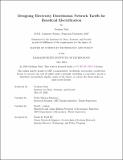Designing Electricity Distribution Network Tariffs for Beneficial Electrification
Author(s)
Turk, Graham
DownloadThesis PDF (3.481Mb)
Advisor
Duenas-Martinez, Pablo
Joskow, Paul L.
Terms of use
Metadata
Show full item recordAbstract
Decarbonizing the transportation and residential building sectors will require rapid electrification through the uptake of electric vehicles (EVs) and cold climate heat pumps (CCHPs), respectively. There is broad consensus that the flat volumetric electricity tariffs currently in place for residential customers in most of the US discourage electrification and do not reflect the underlying marginal costs of electricity delivery. Under flat volumetric tariffs, utilities are projecting sharp rises in distribution-level peak demand, which will necessitate network upgrades whose costs are recovered from all grid users. Alternative rate designs can help mitigate the need for these upgrades by shifting new demand away from peak periods. However, there is an emerging narrative that electricity tariff design is a zero-sum game: regulators can either protect vulnerable households or encourage electrification, but not both. In this thesis, we challenge that perception by asking whether well-designed distribution network tariffs can deliver a win-win in the long run, reducing operating costs for EVs and/or CCHPs and average network costs for households that cannot yet afford to electrify. We answer this question by running a series of bottom-up optimizations to simulate household’s responses to alternative network tariff designs in two distinct geographies, then assessing cost impacts on different household groups. We use open-source data on household electricity consumption and travel behavior. We find that beyond very low adoption levels, time-of-use per-kWh network tariffs, which several states have adopted as the default, perform poorly on all metrics and lead to large increases in local peak demand. Per-kW capacity tariffs (subscription and demand charges) are effective at mitigating EV-driven peaks, especially when paired with TOU energy tariffs. We recommend that regulators separate network charges from energy charges and introduce a per-kW subscription network tariff to collect a portion of the network revenue requirement. This approach will reduce the total cost of ownership of electrified devices while mitigating the network upgrades needed to maintain reliability. Our recommendations offer a path towards rapid electrification that benefits all grid users.
Date issued
2024-05Department
Massachusetts Institute of Technology. Institute for Data, Systems, and SocietyPublisher
Massachusetts Institute of Technology